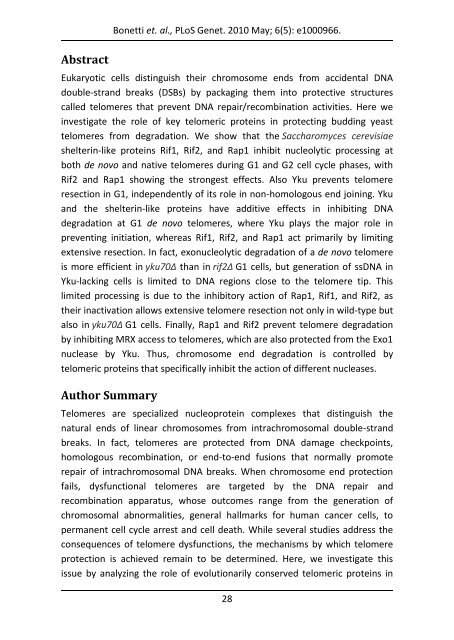View/Open - Università degli Studi di Milano-Bicocca
View/Open - Università degli Studi di Milano-Bicocca
View/Open - Università degli Studi di Milano-Bicocca
Create successful ePaper yourself
Turn your PDF publications into a flip-book with our unique Google optimized e-Paper software.
Abstract<br />
Bonetti et. al., PLoS Genet. 2010 May; 6(5): e1000966.<br />
Eukaryotic cells <strong>di</strong>stinguish their chromosome ends from accidental DNA<br />
double-strand breaks (DSBs) by packaging them into protective structures<br />
called telomeres that prevent DNA repair/recombination activities. Here we<br />
investigate the role of key telomeric proteins in protecting bud<strong>di</strong>ng yeast<br />
telomeres from degradation. We show that the Saccharomyces cerevisiae<br />
shelterin-like proteins Rif1, Rif2, and Rap1 inhibit nucleolytic processing at<br />
both de novo and native telomeres during G1 and G2 cell cycle phases, with<br />
Rif2 and Rap1 showing the strongest effects. Also Yku prevents telomere<br />
resection in G1, independently of its role in non-homologous end joining. Yku<br />
and the shelterin-like proteins have ad<strong>di</strong>tive effects in inhibiting DNA<br />
degradation at G1 de novo telomeres, where Yku plays the major role in<br />
preventing initiation, whereas Rif1, Rif2, and Rap1 act primarily by limiting<br />
extensive resection. In fact, exonucleolytic degradation of a de novo telomere<br />
is more efficient in yku70Δ than in rif2Δ G1 cells, but generation of ssDNA in<br />
Yku-lacking cells is limited to DNA regions close to the telomere tip. This<br />
limited processing is due to the inhibitory action of Rap1, Rif1, and Rif2, as<br />
their inactivation allows extensive telomere resection not only in wild-type but<br />
also in yku70Δ G1 cells. Finally, Rap1 and Rif2 prevent telomere degradation<br />
by inhibiting MRX access to telomeres, which are also protected from the Exo1<br />
nuclease by Yku. Thus, chromosome end degradation is controlled by<br />
telomeric proteins that specifically inhibit the action of <strong>di</strong>fferent nucleases.<br />
Author Summary<br />
Telomeres are specialized nucleoprotein complexes that <strong>di</strong>stinguish the<br />
natural ends of linear chromosomes from intrachromosomal double-strand<br />
breaks. In fact, telomeres are protected from DNA damage checkpoints,<br />
homologous recombination, or end-to-end fusions that normally promote<br />
repair of intrachromosomal DNA breaks. When chromosome end protection<br />
fails, dysfunctional telomeres are targeted by the DNA repair and<br />
recombination apparatus, whose outcomes range from the generation of<br />
chromosomal abnormalities, general hallmarks for human cancer cells, to<br />
permanent cell cycle arrest and cell death. While several stu<strong>di</strong>es address the<br />
consequences of telomere dysfunctions, the mechanisms by which telomere<br />
protection is achieved remain to be determined. Here, we investigate this<br />
issue by analyzing the role of evolutionarily conserved telomeric proteins in<br />
28

















